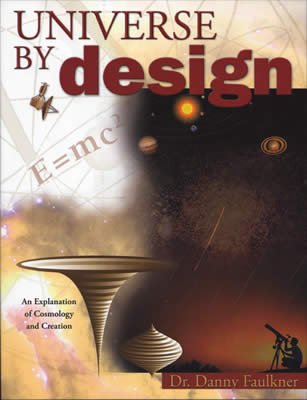Introduction
The first few chapters of the Bible describe what I, the author, believe to be the origin and early history of mankind, the earth, and the universe. Even a cursory reading of the Book of Genesis by anyone reasonably scientifically literate ought to result in awareness that the biblical and scientific stories of creation are markedly different. Not wanting to live in a fragmented world of the Bible on Sunday and science the rest of the week, most Christians develop some reconciliation of the two. Either this process results in a world view, or it is based upon an often tacit world view. For instance, one will usually attempt to reconcile the Bible to science or science to the Bible. It is important to understand what one believes in Genesis, because certain rules of biblical interpretation will be established here.
So, what assumptions do I make? I think that it is wrong to reconcile the Bible to science. In this book we will encounter many ideas that were once widely believed and thought beyond dispute, but were later shown to be wrong and were discarded. On the other hand, the Bible does not change. There are many today who interpret Genesis in terms of the latest scientific theories and even fads. If the history of science is any teacher, then we must conclude that many of these ideas eventually will be discarded. If we have staked out a position that Genesis teaches these ideas, then what is to become of Genesis when these ideas are abandoned? A great concern of mine is that many Christians have wedded the creation account of the Bible to the big-bang theory, the current scientific myth of the world’s creation. In a hundred years will anyone believe the big bang? If not, then what is to become of Genesis if we have tied it to the big bang?

Image courtesy of NASA
The Ant Nebula
Attempts to reconcile the Bible to modern science include, but are not limited to, the following: theistic evolution, progressive creation, the gap theory, the day-age theory, and the framework hypothesis. Theistic evolution is the belief that biological evolution, as understood by most scientists today, was God’s method of creation. Progressive creationists do not believe that different kinds of creatures evolved from other kinds, but instead think that God repeatedly intervened to instantaneously create new kinds of organisms throughout time. Extinctions then acted to eliminate many of those kinds of creatures. Thus theistic evolutionists and progressive creationists agree on when various organisms came into existence, but differ on how those organisms came into existence.
Both progressive creation and theistic evolution require vast periods of time, so some accommodation for the six days of the creation week must be made. The most common approach is the day-age theory, that is, that each of the days of the creation week were long periods of time. Some who reject both theistic evolution and progressive creation still feel compelled to allow for vast ages of millions or billions of years in the earth’s past. In an attempt to permit this, the gap theory is the belief that there was a long period of time between the first and second verses of Genesis chapter 1. Then the six literal days of the creation week commenced with the second verse. The gap theory appealed to many people who wanted to interpret the Bible as literally as possible, but the gap theory has increasingly fallen onto hard times with the rise of modern creation science.
In recent years the framework hypothesis has made large inroads among conservative Christians who take the Bible seriously. The framework hypothesis is the idea that the first ten chapters of Genesis are poetry, not history. As such, those chapters have rich meaning, but do not reflect actual history. In this view, the Bible is silent on the how and when of the origin of the world, and so the believer is free to adopt whatever modern science has to say about these questions. All of these accommodations of Genesis to modern science have difficulties, a topic that will not be further developed here.1
What is the viewpoint of this book? The days of the creation week are best understood as literal days, not long periods of time. While the Bible does not tell us the date of creation, the strong implication is that the creation was only a few thousand years ago. There is a fairly complete chain of biblical chronologies from the creation to the time of Christ. Those chronologies add up to about 4,000 years. Adding the two millennia since the time of Christ, we determine an age of the world of about 6,000 years, though some understandings of the chronologies could stretch the age by nearly a thousand years. (Note that the precision of the Ussher chronology [4004 B.C. as the date of creation] is not possible).
In any case, a faithful rendering of biblical chronologies will not allow for millions or billions of years for the age of the universe as demanded by modern science. Therefore, the approach that we take here is very different from the approach that nearly every other book on cosmology takes. At the time of the writing of this book, cosmologists generally estimate the age of the universe between 12 and 14 billion years. One particular study dated the age of the universe at 13.7 billion years, plus or minus 1%. We estimate the age at about 6,000 years. One would expect that this dramatic difference in estimated age must lead to tremendous differences in cosmology. Indeed, the standard big-bang model assumes a purely physical, natural origin to the universe, while we assume that God created the world and revealed some of His process of creation in Genesis. That is, the origin of the universe was a supernatural event. This difference of opinion between theism and (at the very least practical) atheism is even more profound than the age issue.
What is Cosmology?
The word cosmology comes from the Greek words cosmos and logos, which literally mean “world” and “word.” As with the names of many sciences, logos has been generalized to mean “study of,” while cosmos is generally understood to mean the universe. So the word cosmology means the “study of the universe” as a whole. More specifically, cosmology is the “study of the structure of the universe.” A related word is cosmogony,which refers to the “study of the history of the universe.” Today the word cosmogony is not used much, and much of what is called cosmology is technically cosmogony.
A cosmology is a particular theory or statement about how the universe or some part of the universe operates. For instance, the heliocentric theory, the idea that the sun is the center of the solar system, is a cosmology. The geocentric theory, that the earth is the center of the solar system, also is a cosmology. The idea that stars are very distant suns is a cosmology too. Another example of a cosmology is Immanuel Kant’s island universe concept. At the beginning of the 20th century, many astronomers thought that our galaxy, the Milky Way, was the only galaxy. Thus, they often referred to the Milky Way as “the universe.” Many faint patches of light seen through telescopes generally were thought to be clouds of gas within our galaxy. However, much earlier Kant had suggested that many of these faint objects were other galaxies, each containing billions of stars. Since these “universes” were separated by huge gulfs of space, they were compared to islands. This theory was eventually proven to be correct, as we shall see.
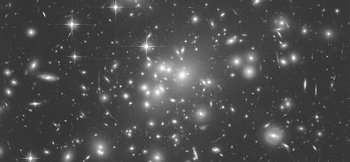
Image courtesy of NASA
Abell 1689 is one of the most massive galaxy clusters known.
The cosmologies that will be considered in this book will be those that are concerned with the structure of the universe as a whole. Since the mid-1960s there has been one dominant cosmology: the big bang. We will examine the historical developments and observations that led to the big-bang theory. We will discuss alternatives to the big-bang cosmology, such as the steady-state cosmology and the plasma universe. Besides the physical data, we will be very concerned with how well various cosmologies conform to biblical data. Creationists have recounted many problems with the big bang, and some of those problems will be discussed here. However, it is important that creationists go beyond criticizing non-biblical or evolutionary cosmologies and develop our own positive models. Unfortunately, only meager progress to this end can be reported at this time, but avenues of possible research will be suggested.
In this introduction let us explore some more restricted cosmologies of the past. Cosmological ideas are as old as mankind. We have no idea what kind of cosmologies Adam may have had. Many people think that since Adam and his immediate descendents lived so long (in many cases nearly a millennium), the earliest people may have developed some amazing ideas and technology. There is no evidence, but it is possible that the antediluvian society may have produced some very sophisticated cosmologies. There are records of many primitive cosmologies2 from around the world. Evolutionists usually conclude that these primitive cosmologies represent the original thoughts of ancient people. From the creation standpoint we would expect that what we refer to as primitive notions are actually declines from some earlier, more advanced ideas. Given that there is no direct evidence to support this creationary conjecture, let us start with some of the earliest known cosmologies.
Ancient Cosmologies
Most primitive cosmologies start with some version of a flat earth with a sky suspended above it. The earth certainly appears flat locally, so this is not an unreasonable starting point. Most people today erroneously believe that the concept of a flat earth remained common until about the time of Christopher Columbus five centuries ago. Actually, belief in a spherical earth had been nearly universal among knowledgeable people for at least two millennia before the time of Christopher Columbus.
How did the ancients figure out that the earth was spherical? The ancient Greeks gave several arguments for the earth’s sphericity, but we will only discuss the two better ones here. The ancient Greeks knew that a lunar eclipse is the shadow of the earth falling on the moon. They also noticed that the earth’s shadow was always exactly circular in shape, regardless of the orientation of the earth at the time of the eclipse. If the earth were disk shaped, it would be round-but-flat and would cast circular shadows, but only when an eclipse occurred near midnight. For eclipses near sunrise or sunset the sun’s rays would strike a flat earth obliquely, and would produce an elliptical shadow, but not a circular one. The only shape that always casts a circular shadow is a sphere. Since all lunar eclipses showed that the earth’s shadow is consistently circular, the Greeks concluded that the earth was spherical.
Another argument for the sphericity of the earth stemmed from the travel and exploration of the Mediterranean world by ancient Greek and other mariners. There was a major trading route between Greece and Egypt. The ancients noticed that stars that were barely visible in the southern sky in Egypt were not visible at all in Greece. Conversely, stars barely above the northern horizon in Greece were not visible in Egypt. This is due to the fact that the north celestial pole is at a higher altitude, or elevation in the sky, in Greece than in Egypt. This can only happen if Greece and Egypt are at different locations along a curved surface. Today we would say that Greece and Egypt are at different latitudes. Any travel north or south revealed the same phenomenon. A similar thing can be seen in the rising or setting times of the sun as one travels east or west. For instance, there is a three-hour difference between the east and west coasts of the United States. The ancients failed to notice this time difference in east-west motion, because they lacked the accurate clocks and rapid transportation that we have today.
More than 2,000 years ago, Eratosthenes, a Greek astronomer living in Alexandria, made use of this phenomenon to measure the size of the earth. Eratosthenes noticed that on the summer solstice near Aswan in modern day southern Egypt, no shadows of vertical objects were cast at noon. This is because the sun was directly overhead at noon on that date, and today we would say that this location is on the tropic of Cancer, the northern extent of the tropics. At noon on the same date (but obviously not the same year) Eratosthenes noticed that objects did cast shadows in Alexandria. The difference in the shadows at these two locations obviously meant that the two locations were on an arc, and thus the earth’s surface is curved. Eratosthenes measured the lengths of the stick and its shadow in Alexandria and used trigonometry to find that the sun made an angle of 7° with the zenith, the point directly overhead. Seven degrees is about 1/50 of the circumference of a circle, so Eratosthenes knew that the circumference of the earth was 50 times the distance between the two cities. The answer that he got was within 1% of the correct value.

Image courtesy of Bryan Miller
The difference in the shadows shows not only that the two locations are on an arc, but this phenomenon was used to calculate the size of the earth.
Sometimes creationists are accused of trying to introduce something akin to the flat earth. This plays upon the common misconception that until about 500 years ago nearly everyone believed in a flat earth and that the Church taught that the earth was flat. This is utter nonsense—the Church never taught that the earth was flat. Indeed, the high regard for Aristotle and other ancient Greeks by the medieval Church necessitated that ancient Greek ideas on the earth’s shape be included in the teachings of the Church. This unfair attack upon creationists can be traced to the latter half of the 19th century in an attempt to discredit those in the Church who defied the acceptance of Darwinian evolution.3
As an aside, we should consider for a moment just what was involved in the medieval Church’s adoption of ancient Greek thought. Augustine taught that at the fall of man in the Garden of Eden, it was man’s will and moral character that fell, not man’s intellect. Man was still capable of perfect reason. The Church eventually saw in Aristotle and other Greek philosophers the best of what man’s perfect intellect could produce. Arguing that all truth is God’s truth, most of ancient Greek philosophy was adopted as dogma. This is most strange, considering that all ancient Greek philosophers were pagan. If they believed in any gods, they would have been polytheists. As we shall see later, ancient Greek philosophy taught evolution and an eternal universe. Both of these should have been anathema to the Church, but instead these two heretical ideas subtly slipped into western thought.
The most obvious astronomical motion in the sky is the daily rising and setting of the sun. It does not require much thought to eventually figure out that it is the same object that rises and sets each day. Next, one can reason that the sun spends the time at night passing under the earth to rise again in the east in the morning. From this it is easy to conclude that the sun is doing the moving. In other words, the geocentric theory is a good starting model. Ancient and primitive cultures concocted various explanations for the sun’s motion. Most involved either the sun being a deity that traveled across the sky each day or an object that was ridden or propelled by a deity or other creature across the sky each day. Many cultures considered what the sun was doing as it traveled under the earth each night. All of these considerations amount to a cosmology.
Probably the next step was to notice that other objects in the sky shared in the east-to-west motion of the sun. The moon and most of the stars rise in the east and set in the west each day as well. To most people the sky appears to be round, like a sphere. Many Mediterranean cultures adopted the cosmology of the celestial sphere. This is the idea that the stars, moon, and sun are lights placed upon a hard, transparent sphere centered on the earth. Either the earth remained absolutely motionless as the sphere spun around the earth each day, or the celestial sphere remained motionless while the earth rotated each day. Either one of these options would be a geocentric model. Many people today assume that all ancient people believed that the earth did not spin, but this is not necessarily true. Once the ancients figured out the correct shape of the earth and had traveled over a few hundred miles, they recognized that at all points on the earth bodies are attracted by gravity toward the earth’s center. Therefore there was no danger in falling off the earth as it spun.
The question of strict geocentricity does not arise until motions taking quite a bit more than a single day are considered. From night to night the moon appears to move about 14° eastward with respect to the background stars. The length of time required for the moon to make one complete orbit with respect to the stars is 27⅓ days, or one sidereal month. So while the earth or celestial sphere is rapidly spinning each day, the moon is more slowly moving around the earth or celestial sphere once a month. Most ancient societies correctly deduced that this was the orbital period of the moon around the earth. Things got murkier as the motion of the sun was considered. Each day the sun moves about 1% eastward through the stars, taking one year to make one trek around the celestial sphere. The question is whether this is motion around the earth similar to that of the moon, or is it the motion of the earth around the sun? Both the geocentric and heliocentric cosmologies produce the same observed motion just described.
Most people today are under the incorrect impression that nearly all ancients believed that the sun orbited the earth because of certain philosophical biases. Actually, some ancients conducted an experiment to test which idea was true. They reasoned that if the earth orbited the sun, then the observed positions of stars on the celestial sphere ought to shift slightly as we view them from one side of the earth’s orbit to the other. This effect is called parallax, which you can demonstrate by viewing your thumb held at arm’s length with one eye and then the other eye. Your thumb will appear to shift back and forth with respect to background objects as you look with one eye and then the other. If we view nearby stars on one side of the earth’s orbit and then the other side of the orbit six months later those stars will appear to change position. Parallax is caused by a change in viewing position along what is called a baseline. Surveyors use this principle all the time to measure the distance to points that are far away. The amount of parallax shift that we see depends upon the size of the baseline (the earth’s orbit in the case of stars) and the distance to the object in question. For a given baseline, parallax will decrease with increasing distance to the object.
The ancients diligently searched for parallax, but did not find it. They could not appreciate the fact that stars are at incredible distances. The nearest star is about 275,000 times farther from us than the sun, so the total annual shift that the nearest star experiences is the equivalent of the apparent diameter of a dime viewed from about one and a half miles away! Being good scientists, they rejected the heliocentric theory in favor of the geocentric cosmology. There were a few ancients that believed the heliocentric theory anyway, primarily upon the basis that the model was simpler, but they did so against the best evidence of the time.

Image courtesy of Bryan Miller
Parallax diagram
The earliest mention of someone teaching the heliocentric model is Aristarchus of Samos (310–230? B.C.). Aristarchus used geometric arguments to measure the sizes of the moon and sun as well as their distances from the earth. He found that the moon was ⅓ the size of the earth and that the moon’s distance was 10 times the diameter of the earth. Actually, the moon is ¼ the size of the earth and its distance is about 30 times the diameter of the earth. Aristarchus measured the sun as 7 times bigger than the earth and its distance was 200 times the diameter of the earth. The modern values are 109 and nearly 12,000. Still, these were remarkable measurements that were quoted for centuries afterward. Since the sun is much larger than the earth, Aristarchus reasoned that it was more logical to conclude that the earth orbited the sun rather than the other way around. He explained the lack of parallax by concluding that the stars are very distant, which is, of course, correct.
Heliocentric and Geocentric Cosmologies
The path that the sun appears to follow along the celestial sphere each year is called the ecliptic. The moon’s orbit is inclined to the ecliptic a little more than five degrees. Of the few thousand stars visible to the naked eye, the ancient astronomers found that nearly all of them remained fixed on the celestial sphere. The only exceptions were five fairly bright stars that they called wandering stars. The Greek name meaning “wandering star” has come down to us as planet. Since all of the planets orbit the sun in nearly the same plane as the earth, the motions of the planets are always near the ecliptic.

Image courtesy of Bryan Miller
Geocentric diagram
While the planets moved close to the ecliptic, they seemed to follow erratic motions, which suggested the property of volition. Therefore, most ancient cultures conferred the status of deity upon the five planets, along with the sun and the moon. Our names for the five naked-eye planets come from the Roman pantheon: Mercury, Venus, Mars, Jupiter, and Saturn. With the discovery of Uranus, the first telescopic planet, in the eighteenth century, the practice of using Roman names was continued.
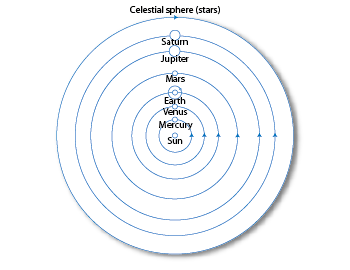
Image courtesy of Bryan Miller
Heliocentric diagram
The motion of the planets among the stars is usually from west to east. This is called direct, or prograde, motion. However from time to time the direction reverses so that the planets travel westward. This motion is called indirect or retrograde motion. Soon afterward, the motion returns to direct. For Mars, Jupiter, and Saturn, which orbit the sun farther from it than the earth, retrograde motion occurs when they are nearly opposite the sun on the celestial sphere. Mercury and Venus orbit the sun closer than the earth does, and retrograde motion occurs when they move from being east of the sun in the evening sky to being west of the sun in the morning sky. Mars, Jupiter, and Saturn are called superior planets, while Mercury and Venus are called inferior planets.
How can retrograde motion be explained with the heliocentric and geocentric cosmologies? The heliocentric model can explain it very easily, as shown below. The orbital speeds of planets decrease with increasing distance from the sun. When the earth at the position marked “opposition” passes a superior planet, the faster motion of the earth causes the superior planet to appear to fall behind. This is retrograde motion. At other times the combined motion of the superior planet and the earth cause the planet to appear to move in the prograde direction. When an inferior planet passes between the earth and the sun, it is the earth that is left behind, which causes the inferior planet to appear to move backward for a short while. The simplicity of this rather straightforward explanation has always been the primary argument in favor of the heliocentric theory.
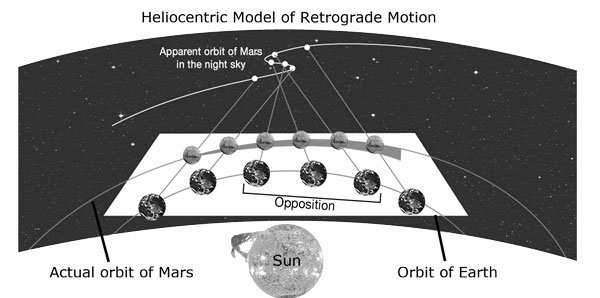
Image courtesy of Bryan Miller
How is retrograde motion explained in the geocentric theory? The most complete explanation comes from Ptolemy, a second-century Alexandrian astronomer. He wrote a compilation of all ancient astronomy in a book that has come down to us by the title The Almagest. Since no original or copies of earlier astronomy texts exist, most of what we know of ancient Greek astronomy comes from this source. Ptolemy could have simply had the planets move on erratic paths along the ecliptic, but this would have offered no predictive power. That is, one could not anticipate nor predict where planets would be at any time in the past or future. Furthermore, the ancients reasoned that objects in the sky must follow perfect motion. The most perfect shape was the circle, and the most perfect motion was uniform. Therefore the ancient Greeks thought that planets must move uniformly along circular paths.
Ptolemy managed to explain retrograde motion by having each planet move upon two circular paths simultaneously. A planet moved along a smaller circle called an epicycle, while the epicycle moved around the earth along a larger circle called a deferent. A deferent went completely around the sky along the ecliptic. By adjusting the sizes of the circles and the rates of motion Ptolemy was able to reproduce direct and indirect motion of the planets pretty well. See the drawing on page 12 for an illustration of how this system works.
Further refinements allowed this system to reproduce planetary motions. For example, the planets do not follow simple back and forth motions when they retrograde. Because the orbits of the planets are slightly inclined to the ecliptic, the motions are flattened loops or flattened s shapes, depending upon at which portions of the orbits that retrograde motions occur. One can reproduce the looping motion by introducing smaller epicycles perpendicular to the other epicycles already discussed.
Ptolemy also found that he got better agreement when he placed the earth off-center of each deferent. This was an attempt to match the elliptical orbits of the planets, a fact elucidated by Johannes Kepler (1571–1630) as his first law of planetary motion in the early seventeenth century. The elliptical orbits of the planets are close enough to being circles that off-center circles can approximate them. Kepler’s second law dictates the rates at which planets move in their orbits. The result is that planets move most rapidly at perihelion, the point of closest approach to the sun, and most slowly at aphelion, the point of greatest distance from the sun. Ptolemy mimicked this by having each planet move at a uniform angular rate with respect to a point called the equant. The equant is collinear with the earth and the center of the deferent, opposite the center of the deferent from the earth, and equal distance from the center as the earth.
Medieval and Renaissance Cosmologies
The Ptolemaic system worked very well to predict planetary positions. By the time of Kepler, the errors between the model and reality were remarkably small. Further refinements (epicycles upon epicycles) could be and were added to improve the agreement. It is not clear if Ptolemy meant for his model to be taken as an absolute statement of how the universe really worked, or if it was merely a computational device. Whatever Ptolemy intended, by medieval times most people thought that was actually how the celestial world operated. Despite its ability to predict planetary positions, the Ptolemaic system was very cumbersome. It is said that when one late medieval monarch was instructed on the Ptolemaic cosmology, he commented that had he been present at the creation he could have offered God a few suggestions.
The complexity of the Ptolemaic cosmology led to the pursuit of simpler explanations. In 1542, nearly one hundred and fifty years before Newton’s work, Nicklaus Copernicus (1473–1543) published his book on the heliocentric cosmology. Copernicus is usually given credit for originating or at least establishing heliocentricity. This is not exactly true, because many others had previously believed in heliocentricity. Perhaps his greatest contribution was his development of the model. Using the heliocentric theory Copernicus found the correct orbital periods of the five planets then known. He also found the distances of the five planets from the sun. Copernicus expressed these distances in astronomical units (AU). One AU is the average distance between the earth and the sun. It would be many years before anyone would know the length of the AU in miles or kilometers, but this is not important, since often all that matters is the relative distances.
Neither of the sizes nor periods of the planets’ orbits had been known previously. Kepler needed this information when he determined his third law of planetary motion in the early 16th century. By the time of Newton in the latter part of the 17th century, the geocentric theory was largely discarded in favor of the heliocentric theory. Direct evidence of the heliocentric option came about much later (aberration of starlight and parallax), but the debate was settled to the satisfaction of most people from the argument of simplicity. The principle of Occam’s razor dictates that when confronted with two explanations that equally explain data, the simpler explanation is usually the correct one.

Image courtesy of Bryan Miller
Tycho Brahe (1546–1601)
An alternate geocentric model should be mentioned. Tycho Brahe (1546–1601) was a famous Danish astronomer who made many very accurate measurements of stellar and planetary positions. The most remarkable part of his story is that he did this all without optical aid, because he died just a few short years before the invention of the telescope. Tycho realized how unwieldy the Ptolemaic cosmology was, but he was unwilling to totally let go of geocentricism, so he devised a sort of compromise cosmology. In the Tychonic model, the other planets orbit the sun, but the sun in turn orbits the earth. (See illustration on page 16.) This is not as different from the heliocentric model as it may seem at first. The Tychonic cosmology is mathematically a coordinate transformation between the earth and sun. There is a modern geocentric movement that embraces this system, and includes a small minority of recent creationists. The author of this monograph does not endorse this movement.4
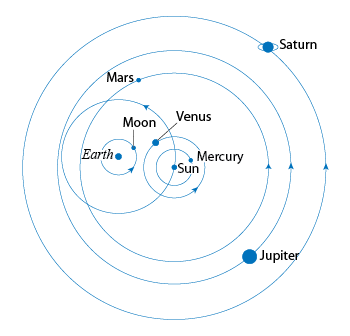
Image courtesy of Bryan Miller
The Tychonic Model
Contrary to popular belief, Galileo Galilei (1564–1642) did not invent the telescope, though he was the first to put the telescope to astronomical use. With his telescope Galileo saw several things that challenged conventional cosmological thoughts of the day. Galileo saw mountains and craters on the moon and spots on the sun, though these bodies were supposed to be perfect and hence without blemish. He saw many thousands of stars too faint to be seen with the naked eye. At the time many thought that there were only 1,022 stars. This stems from the belief that all things worth knowing were known to the ancients and that Ptolemy had cataloged 1,022 stars. Of course Ptolemy had not claimed that he had cataloged all stars. Indeed, his catalog had more stars than those cataloged by earlier Greek astronomers; he had merely cataloged all the stars that he could easily identify. If the authorities had merely considered the words of God in His covenant with Abram recorded in Genesis 15:5 rather than relying upon a garbled understanding of Ptolemy’s words, they would have realized that the stars are without number.
This episode concerning the number of stars sheds light upon what actually transpired when Galileo ran afoul of the Church on the issue of geocentricism. The usual understanding today is that Galileo and others got into trouble for teaching heliocentricism because Church leaders thought that the Bible taught geocentricism. Scripture was rarely used in the prosecution. Instead, the works of Ptolemy were used. This is a strange approach if the question is really theological or religious in nature. We can understand this by recalling that during the middle ages all authority was collected in one place: the Church. The authority included religion, society, government, business, education, and science. A king could not rule, people could not marry or have businesses, and one could not attend school without the blessing of the Church. Most art and science was pursed with the patronage of the Church. Copernicus was a priest, and Galileo had much interaction with the Church. When Galileo and others proposed the heliocentric theory, it was not so much that they were challenging religious doctrine, as it was that they were challenging the science of the day. In other words, the conflict was over old science versus new science, not religion versus science. Given this reality, if one wishes to make a parallel between the Galileo episode of four hundred years ago to the rise of modern creation science, the creationists are to be identified with Galileo. Of course this is just the opposite of the usually intended parallel.
What evidence did Galileo offer for the heliocentric theory? He discovered and named the four large satellites orbiting Jupiter. He realized that he had found four astronomical bodies that did not revolve around the earth, in contradiction to the dogma of the day. Defenders of geocentricism had claimed that if the earth moved, the moon would be left behind. That argument was undermined by the fact that in either the geocentric or heliocentric theories, Jupiter must move, yet its satellites managed to keep up with it. Galileo went on to suggest that Jupiter and its moons represented a sort of miniature solar system. Galileo also saw that Venus went through a complete range of phases, which it could only do if it orbited the sun. This ruled out the Ptolemaic cosmology, though it could not rule out the Tychonic model.
The Nature of the Universe
Given the important role that ancient Greek thought had upon the development of science, it is important to explore their ideas about the universe as a whole. The ancient Greeks thought that the universe was eternal, without beginning or end. This assumption became so deeply ingrained that it is difficult for us to totally understand why they believed it. One possibility is that they had a hard time conceiving of the beginning of the universe. If the universe had no beginning, then that nasty problem may be avoided. That sort of thinking has survived until today. The Greek gods were quite limited in their power—they were not much more than supermen. These gods were finite beings in a transcendent universe. They were born at some time in the past, and presumably would eventually die. The Greeks could not comprehend a Creator that transcended the universe.
Another explanation why the Greeks believed in an eternal universe is that they were evolutionists. Contrary to popular misconception, evolution did not start with Charles Darwin’s Origin of Species in 1859, or even with Lamarck a few decades earlier. The idea of spontaneous generation goes back at least to the ancient Greeks. They also realized that the universe tends to go from order to disorder. However they believed that vortices stirred portions of the universe in such a fashion that order occasionally arose. Variations on this theme still survive in Western thinking today.
Augustine, and later Thomas Aquinas, had a strong influence upon the development of the thinking of the Church and the philosophy of Western thought and science. Augustine brought in many ancient Greek ideas, and “Christianized” many of the formerly pagan concepts. While Augustine may have not believed in an eternal universe himself, his lead allowed that sort of idea to remain in vogue. The big-bang cosmology of the 20th century reintroduced the concept of the universe having a beginning. This was a clean break from the thinking since the 17th century when what we now know as science began to develop. Though some scientists in that interval may have believed in a recent origin of the earth, many of them undoubtedly believed in the eternality of the universe as a whole.
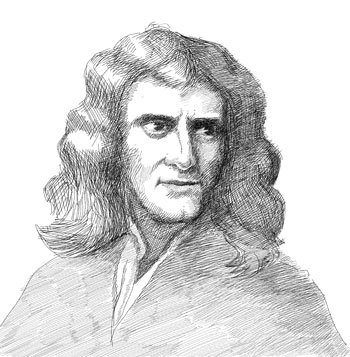
Image courtesy of Bryan Miller
Isaac Newton
As an example of someone who believed in the eternality of the universe, consider Isaac Newton. After Newton devised his law of gravity, he realized that all of the matter in the universe attracted all the other matter. If the matter in the universe were finite in size, then there must be a center of mass. If the universe has a center of mass, then the center must be the point toward which all matter in the universe is attracted. If the universe is eternal, as Newton apparently believed, then there should have been ample time for all matter to be amalgamated at the center of mass. This obviously has not happened.
Newton solved this dilemma not by scrapping the eternality of the universe, but by hypothesizing that the universe was infinite in extent. He reasoned that if the universe extended infinitely in all directions, then there would be no center of mass. All matter would be equally attracted in all directions, so that there would be no collapse of all matter into a single heap. The eternality and infinite size of the universe persisted for two centuries. We shall see that with general relativity this option is not viable in the general case.
Toward Modern Cosmology
About a century after Newton, a clear picture of the structure of our galaxy, the Milky Way, began to emerge, largely through the work of the German-born English astronomer William Herschel (1738–1822). Herschel’s model was called the grindstone model, because its distribution of stars was in a round, flat shape similar to a grindstone. This model placed the sun near the center of the Milky Way, not because of philosophical presuppositions, but because that was where the observational data placed it. In every direction along the plane of the Milky Way, Herschel’s counts of stars at ever-fainter degrees of brightness changed as one would expect if the sun were at the center. It appeared that we were seeing to the edge of our galaxy in every direction.
In the early part of the 20th century, the American astronomer Harlow Shapley (1885–1972) found that the sun was not at the center of our galaxy. He did this by studying the distribution of globular star clusters. Shapley plotted the hundred or so globular clusters then known and found that while their common center was along the plane of the Milky Way, that center was many thousands of light years away from the sun. Since each globular cluster contains at least 50,000 stars, the globular star cluster system as a whole must have a mass many millions of times that of the sun. Shapley argued that it made more sense for the center of the globular cluster system to be the true center of the Milky Way rather than the sun.
Why star counts made it appear as if the sun were at the center of the galaxy remained a mystery for over a dozen years. In 1930 the existence of interstellar dust was discovered. Dust scatters, and thus dims, the light from stars. The amount of scattering is dependent upon the wavelength, or color, of the light. Blue light (shorter wavelength) is scattered more than red light (longer wavelength) so that the transmitted light is changed in color. Viewed through dust, a star appears fainter and redder than it ordinarily would, and if there is enough dust, the star may not be visible at all. This process is well understood, and astronomers routinely correct for this sort of thing today. There is so much dust in the plane of the galaxy that it is not possible to see completely to the edge, at least not in the visible part of the spectrum. We now recognize that obscuration by dust explains why star counts had incorrectly suggested that we were at the center of the Milky Way.
Shapley played a role in another cosmological debate, though this time on the losing side. In 1920 Shapley debated Heber Curtis in Washington, DC, in a program sponsored by the American Academy of Science. At question was Kant’s island universe theory. Most astronomers had thought for a long time that the Milky Way was the only galaxy. In fact, the words galaxy and universe were used synonymously. Through the telescope thousands of faint patches of light can be seen. These were called nebulae (singular: nebula), after the Greek word for cloud, because these objects often appear cloudy. With larger telescopes some of the nebulae can be resolved into stars, and these became known as star clusters. However, most of the nebulae remained fuzzy.
Many of the nebulae had flat, circular or elliptical shapes that reminded Kant and others of Herschel’s grindstone model. Therefore some thought that these might be very distant “universes” like the Milky Way. However, most astronomers interpreted the nebulae as clouds of gas within the Milky Way. The gas cloud theory remained more popular, largely because it fit so well with Laplace’s nebular hypothesis. The nebular hypothesis was the idea that the solar system formed from a flat, rotating disk of gas. The modern theory of solar system formation is the intellectual descendent of the nebular hypothesis. A hundred years ago astronomers used the existence of “spiral nebulae” as proof of the nebular hypothesis.
In their debate Curtis argued for the island universe, while Shapley argued that the Milky Way was the sole galaxy. By all accounts Shapley won the debate, primarily because the data as then understood better supported his position. His victory was short-lived, because just four years later, in 1924, Edwin Hubble (1889–1953) confirmed the island universe theory. Hubble did this with very long photographic exposures of the Andromeda galaxy (M31) made with the Mt. Wilson 100-inch telescope, then the largest telescope in the world. The photographs revealed faint individual stars in M31 that were identified as normally very bright giant stars. This could only be true if M31 were extremely far away (at the time, Hubble estimated its distance as nearly a million light years away), which placed M31 well outside of the Milky Way. Because M31 appeared to be the largest and brightest of the spiral or elliptical “nebulae,” it followed that the others probably were even more distant galaxies, a conclusion that soon was confirmed.
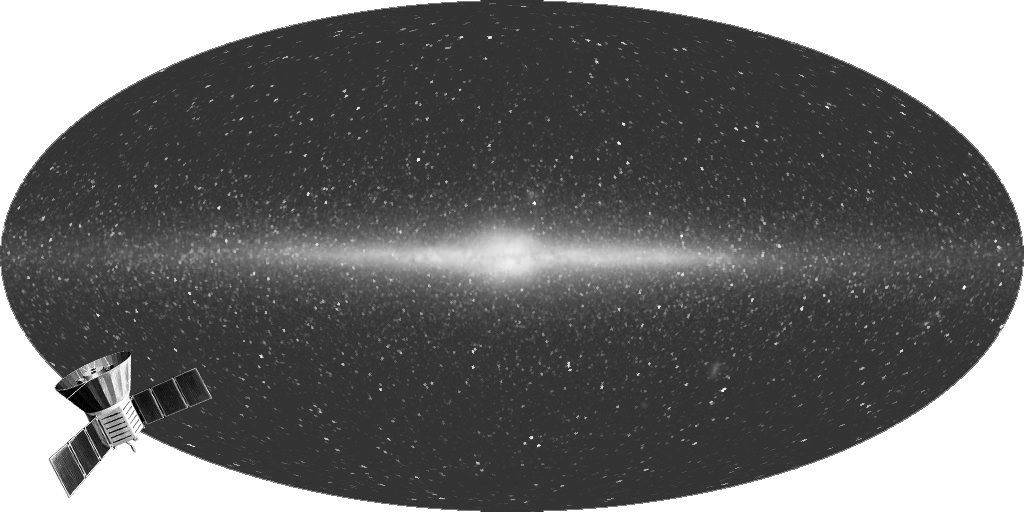
Image courtesy of NASA
The above picture was taken by the COBE satellite and shows the plane of our galaxy in infrared light.
Shapley’s correct positioning of the sun off-center in our galaxy has been hailed as the continuance of the Copernican revolution. Just as Copernicus showed that the earth was not the center of the solar system, we are not even the center of the Milky Way. Hubble’s confirmation of the island universe theory is often taken as the ultimate triumph of the Copernican revolution. Not only are we not the center of the solar system or even of the galaxy, but also the Milky Way is merely a tiny island amidst a vast archipelago of countless galaxies. Many believe that this suggests that mankind is just the result of a relatively minor cosmic accident and that life must have arisen countless times in the universe.
Others go so far as to conclude that the Copernican revolution has somehow disproved the Bible. Of course this erroneously supposes that the Bible claims that we are the center of the universe or at least in some preferred geographical location. While it is clear that mankind is the center of God’s attention, that does not mean nor does the Bible claim that we are at some unique geographic position. The Bible does not address that issue.
In fact, this last step in the Copernican revolution should cause Christians to ponder the fact that despite our apparently insignificant location, the LORD has seen fit to concern himself with us. The modern view of the universe also allows us to better appreciate the mighty power of the Creator. We now better appreciate more than ever before that the heavens do declare the glory of God.
Checking Your Understanding
- What is cosmology? What is cosmogony?
- What was one proof that the ancients used to show that the earth was spherical?
- What did Eratosthenes do?
- What is the geocentric model?
- What was Copernicus’s great contribution?
- What was the Tychonic model?
- What were two discoveries that Galileo made with his telescope that challenged the thinking of his day?
- What was William Herschel’s contribution to cosmology?
- What was the island universe theory?
Universe by Design
This book explores the universe, explaining its origins and discussing the historical development of cosmology from a creationist viewpoint.
Read Online Buy BookFootnotes
- A good discussion of the gap and day-age theories may be found in W.W. Fields, Unformed and Unfilled (Phillipsburg, NJ: Presbyterian and Reformed, 1978). A partial refutation of progressive creation may be found in M. Van Bebber and P.S. Taylor, Creation and Time: A Report on the Progressive Creationist Book by Hugh Ross (Gilbert, AZ: Eden Communications, 1994), or see H.M. Morris and J.D. Morris, Science, Scripture, and the Young Earth (El Cajon, CA: Institute for Creation Research, 1989), p. 7–10; or A.S. Kulikovsky, “God’s Rest in Hebrews 4:1–11,” Creation Ex Nihilo Technical Journal 13(2): 61–62 (1999). Theistic evolution has been critiqued in many places, such as H.M. Morris, Scientific Creationism (Green Forest, AR: Master Books, 1985), p. 215–220. A discussion of all of these compromising ideas may be found in D. Hall and J. Pipa, editors, Did God Create in Six Days? “From Chaos to Cosmos: A Critique of the Non-Literal Interpretations of Genesis 1:1–2:3,” by J.A. Pipa (Taylors, SC: Southern Presbyterian Press, 1999), p. 153ff.
- Some Christians go so far as to think that God gave Adam the complete story of redemption in the form of the constellation and star names that have been passed down to us, though garbled a bit. This idea has become known as the “gospel in the stars.” For instance, see Frances Rolleston, Mazzaroth (York Beach, ME: Weiser Books, 2001), originally printed 1863; E.W. Bullinger, Witness of the Stars (Grand Rapids, MI: Kregel Publications, 1967), originally published 1893; J.A. Seiss, The Gospel in the Stars (Grand Rapids, MI: Kregel Publications, 1972), originally published 1882; or J. Kennedy, The Real Meaning of the Zodiac (Fort Lauderdale, FL: Coral Ridge Ministries, 1989). For a critical discussion of the gospel in the stars, see D.R. Faulkner, “Is There a Gospel in the Stars?” Creation Ex Nihilo Technical Journal 12(2): 169–172 (1998).
- For a good refutation of the myth that the Medieval Church taught a flat earth, see J.B. Russell, Inventing the Flat Earth (New York: Praeger, 1991).
- For a critical evaluation of modern geocentricism, see D.R. Faulkner, “Geocentricism and Creation,” Creation TJ 15(2): 110–121 (2001).
Recommended Resources

Answers in Genesis is an apologetics ministry, dedicated to helping Christians defend their faith and proclaim the good news of Jesus Christ.
- Customer Service 800.778.3390
- Available Monday–Friday | 9 AM–5 PM ET
- © 2026 Answers in Genesis


